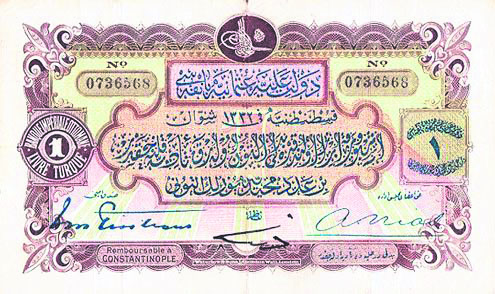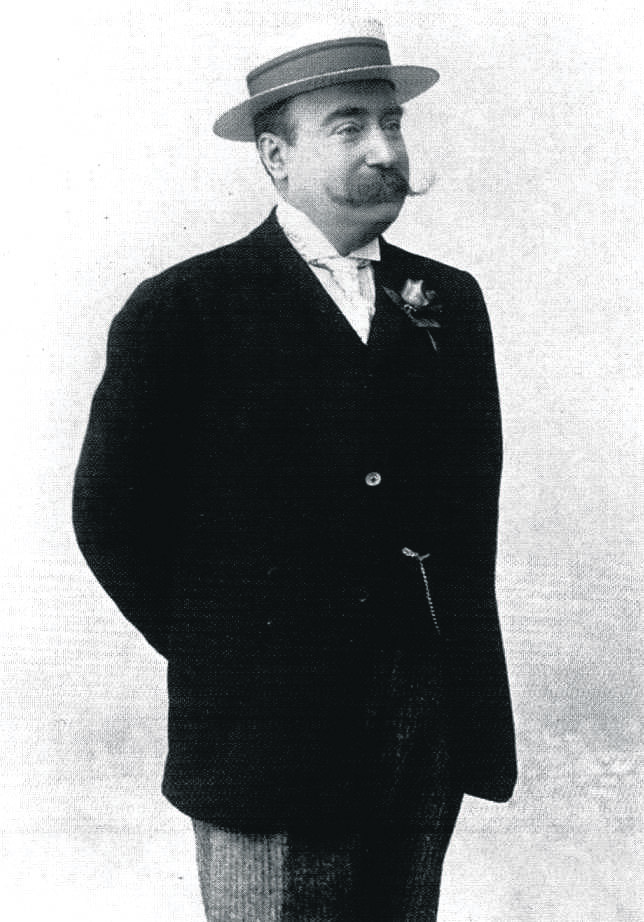A new coin was issued whenever a new sultan ascended to the throne in the Ottoman Empire, yet the currency issued in the name of the former sultan continued to circulate. Foreign currencies were also used for conquests and commercial relations with other countries. This is why there were money changers all over the empire. They were mostly Levantines, who were also involved in basic banking and loan activities.
Some Italian and French merchants who had dominated Mediterranean trade since the Byzantine era, married women from local non-Muslim communities and created the Levantine class. Among them, the Lorando, Tubini, Baltazzi, Corpi, Stefanovic, Shilizzi, Negroponte, Coronio and Alberti families were the most famous. Apart from the Levantines, there were Jewish money changers like Camondo and Fernandez, along with Greek money changers (sarraf) such as Mavrokordato and Zarifi and Armenians such as Köçeoğlu and Mısırlıoğlu. Because the signature on their official work permit given by the state looks like "tail," they were called "money changers with a tail."
Istanbul was the center of overseas trade, financial and jewelry-related transactions, and smuggling was also common. The gold and silver trade also boomed in Europe upon the discovery of the Americas. This also made the profession of money exchangers important in the Ottoman Empire, which was short of cash at that time. The well-known exchangers of the 16th century were Jews who had come from Spain.
Locals, notably the janissaries, used to invest their money through them. In the same century the government began to take out loans from these money changers to close the budget deficit that emerged for the first time in the history of the Ottoman Empire due to prolonged wars. After that, getting loans from money changers became a common practice that continued until the end of the empire.
Armenian money changers emerged in the market in the 17th century. Money changers who lent money in exchange for mortgages became richer by acquiring the properties of debtors who were unable to pay back their loans.

A negative perception of the Jewish community, which was far distant from anti-Semitism, emerged during this time among the eastern Anatolian community. The Jewish-Armenian conflict in the Ottoman Empire began after these developments and resulted poorly for Armenian interests.
These money changers became political and social authorities that threatened bureaucrats and financed military coups with the help of their connections in Europe.
The Ottoman Empire's peaceful era, also called the Tulip Era, from 1718 to 1730, when artistic and industrial movements flourished, ended following an uprising funded by the bankers. It was because the Ottoman government's efforts to increase the value of the Ottoman currency by devaluing silver did not serve the purpose of the money changers based in the Galata neighborhood of Istanbul.
When the directorate of the mint stopped selling silver, the minting process was hindered and trade almost came to a standstill. The government tried to ramp up production and a commerce tax was imposed on merchants to limit exports. In the 19th century, these money changers to whom the government asked for help due to problems in their expenditures, lead them to become bankers. These bankers carried out communication between the Ottoman Empire and the Western European industrial circles after the Industrial Revolution. They undertook agency businesses for the exports that arrived at ports and acquired official contracts. They also financed local merchants, consumers and government officials whose salary payments were delayed. The partnership they created between money changers and merchants allowed these bankers to get agricultural exports at a bargain price, thereby monopolizing financial life in the Ottoman Empire.
Jewish money changers, who dominated trade not only in Istanbul, but also in Egypt and Syria, preferred the authority of the liberal British Empire, instead of hawkish France, and became the followers of British interests. Avram Camondo (1781 to 1873), whose is still known in Istanbul, was one of the prominent figures of this mission. He was born in his family's "new homeland" of Istanbul after his father, Abraham Haim, and mother, Rachel Regine Camondo, migrated to the Ottoman Empire. The Camondo family was originally from Spain and Portugal, but escaped the Spanish Inquisition and lived in Venice for three centuries. They assumed an Austrian identity after Venice became an Austrian territory. The family is said to be related to 19th century British Prime Minister, Benjamin Disraeli. Camondo established "Isaac Camondo and Brother" with his elder brother.
 Isaac Camondo, a banker from the Camondo Family
Isaac Camondo, a banker from the Camondo Family
Avram aquired his elder brother's wealth when he died without a child of his own. His company was a partner of many corporations including Şirket-i Hayriyye, a company that undertook transportation on the Bosporus, and the Tram Company. Camondo was called the "Rothschild of the East" and handled the business of Disraeli as well as Rothschild, who was the leader of global capital at the time.
Upon abolishing the janissary in 1826, Sultan Mahmud II also liquidated the business of Jewish bankers who had financial relations with them. When his young and inexperienced son ascended to the throne, Britain asked him to assign Rashid Pasha as grand vizier in 1839. Camondo was both the banker and close friend of Rashid Pasha. Through this, the Ottoman Empire, fearing the Russian Empire, became Britain's focus point. Camondo was said to have fainted when he learned of Rashid Pasha's death, as he was in heavy debt to Camondo. Those who saw the incident would have probably been surprised to see Camondo's so-called love for him.
As a perfect social entrepreneur who established good relations with sultans, Camondo continued his contact with successive grand viziers. Having been knighted as chevalier by the German emperor and declared an earl by the count of Italy, Camondo was the first foreign Ottoman entitled the concession of property acquisition. He acquired a significant amount of real estate. Camondo also published a Masonic newspaper called Ladino. Despite opposition from rabbis, he was successful in opening the Alliance Israelite School in Istanbul, where Jewish students could receive a modern education. Camondo led Istanbul's Jewish society, turning them into the empire's most powerful community.
Following the death of his only son, Rafael, Camondo settled in Paris and died a year later. Upon his will, Camondo's body was sent to Istanbul and buried in a tomb in the Hasköy neighborhood, which is now dilapidated. His house in Paris, however, was transformed into a flamboyant museum. Camondo's 804-item painting collection is at the Musee d'Orsay. His family disappeared in the Auschwitz concentration camp during the Holocaust.
Many historic buildings that are still standing in Istanbul were established by the Camondo family, including the Kasımpaşa Naval Commandership, apartment buildings in Galata, the Camondo Inn on Serdar-ı Ekrem Street, the Büyükada Inn on Meşrutiyet Street, the Saatçi Inn, Latif Inn, Lacivert Inn, Yakut Inn, Kuyumcular Inn, Lüleci Inn, Gül Inn in Karaköy and Camondo Steps on Bankalar Street. The family had a significant role in Istanbul's modernization process.
The bankers in Galata also made Sultan Murad V dependent on them with loans. When the sultan was overthrown, they attempted to stage a coup a couple of times as a response. The sultan's debt was paid by his brother, Sultan Abdülhamid II, who took the throne after him. Similar to his grandfather, Sultan Abdülhamid II preferred Armenians in financial issues, which nurtured enmity among Jewish bankers. This is because the influential Jewish Ottomans supported members of the Committee of Union and Progress (CUP) and the 1908 coup.
Banking first emerged in Italy in the 13th century and spread all around the world. After the arrival of the Industrial Revolution, banks began to act as important institutions in Europe, where trade significantly flourished. In those years, the Ottoman Empire had close business ties with Europe. It was the same time that the first banks of the Ottoman Empire began to open.
In 1845, the government had taken loans from two bankers in Galata - Alleon and Baltazzi. An agreement was concluded to apply a fixed rate on the pound. In return, they were allowed to open a bank. In 1847, the first Ottoman bank, Derseadet Bankası, opened. However, the bank did not have enough capital to run. Their trade bill was approved thanks to the owners' recognition, but the bank went bankrupt a while later.
To meet the expenses of the Crimean War, the Ottoman government took a loan from Rothschild, a British banker. He was also given prerogative to open a bank. In 1856, Bank-ı Osmani (The Ottoman Bank) was founded in Galata, though headquartered in London, with opening capital bought by a British group. In 1863, a French stakeholder was included and the bank continued to operate under the name Bank-ı Şahane-i Osmani" (The Ottoman Imperial Bank) as a central, commercial and investment bank. The bank is recognized as the Ottoman Empire's first modern bank. It was even entitled to issue currency.
In 1877, the Ottoman government took a loan from Galata bankers and the bank to meet the expenses of the Russo-Turkish War. This loan dragged the government into bankruptcy and the state into a loss, which forced it to establish an entirely new order.


